28th Field Hospital Unit History
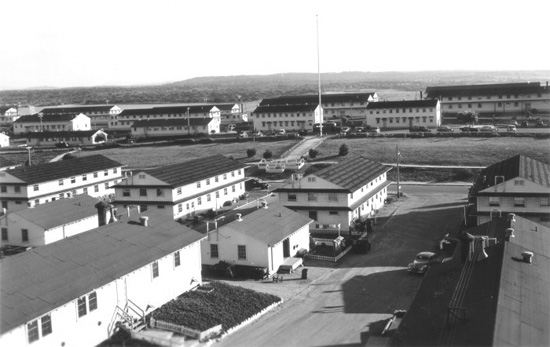
Partial view of administrative and personnel barracks at Fort Ord, Monterey, California, the base where the Kiska invasion troops took their amphibious training. Picture taken in 1941.
Introduction & Activation:
The 28th Field Hospital was activated 16 September 1942. Unit training was completed at Camp Campbell, Hopkinsville, Kentucky (Armored Division camp; acreage 102,414; troop capacity: 2,422 Officers & 45,198 EM –ed). In May of 1943 the Hospital moved to Fort Ord, Monterey, California (Landing Vehicle Board & Army Ground Forces Training Area; acreage 28,690; troop capacity; 51,253 Enlisted personnel –ed), where it was assigned to Amphibian Task Force # 9. This latter Command, after completing amphibious training, undertook the Kiska Island campaign in the Aleutian Islands (it should be noted that 5th Service Command activated the 29th Field Hospital in the same period – 18 Sep 42 – at the same location, both units would later serve together on Kiska).
Enlisted personnel fillers came from various Hospitals, although some of the men had already gone through basic training, most of them had received little training in field and tactical operations, and almost none in medical and administrative work as applied in a Field Hospital. Medical Officers started coming in between mid September and mid October of 1942 and although they had spent some time working and training in Army General and Station Hospitals located in the Zone of Interior, they also lacked field training. An extensive training program based on MTP 8-10 was therefore set in motion essentially based on field operations and tactics.
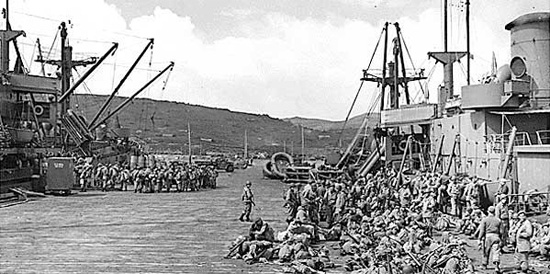
Troops of the 7th Infantry Division (element of ATF # 9) prepare for the Kiska invasion. Picture taken 29 July 1943. The Kiska invasion force consisted of 3 battleships, 2 cruisers, 7 destroyers, 7 transports, 1 LST, and 8 merchant ships.
As far as housing was concerned, Camp Campbell proved satisfactory in general, with some required amendments being made to adapt to the rainy weather (mainly trying to avoid mud and water in drill and tent pitching areas). Training equipment and aids were rather limited and difficult to procure; training films were gradually made available; limited amounts of bandaging supplies and splints were obtained from a nearby Station Hospital; and quite a few Officers and EM were sent to Schools and medical institutions to learn or specialize in the necessary skills. Bivouacs, field marches, field problems took place, being endured in snow – mud – and rain. On 15 May 1943, orders were received for movement to Fort Ord, California, for further training. Following a number of fluctuations, modifications, and transfers of personnel, the organization was well trained in both medical and military subjects, though lacking the necessary complete organic equipment, when it left Camp Campbell, Kentucky.
Upon arrival, the unit was assigned to quarters in wooden barracks, and attached to ATF # 9, with which it was to start an extensive training in amphibious warfare, including dry net and wet net instructions, small boat landings, and boarding, loading, and employment of LST vessels. A familiarization course on firearms was given followed by live firing, participation in the infiltration course, and the whole command was issued firearms prior to embarkation for overseas. It must have been one of the first times that a medical unit was armed deliberately before going into battle! The last move was to San Francisco Port of Embarkation, California.
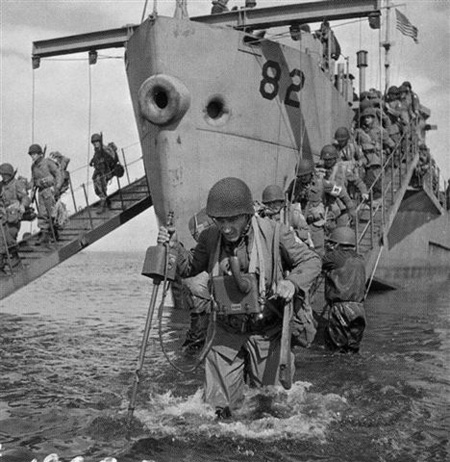
Troops of the 13th Canadian Infantry Brigade land on Kiska Island, Aleutians, 16 August 1943. They are equipped with American equipment, except for weapons and some individual gear.
First Operation Overseas:
The Aleutian Islands Campaign (3 June 1942 – 24 August 1943) covered the struggle over the Aleutian Islands (part of Alaska), in the early Pacific campaign of World War 2. A small Japanese force occupied the islands of Attu (7 Jun 42) and Kiska (6 Jun 42), but the remoteness of the islands and the difficulties of weather and terrain meant that it took nearly a year for the United States to react and eject them. The islands’ strategic value was their ability to control Pacific Great Circle routes and the Japanese thought that capture of the Aleutians would prevent a possible American attack across the Northern Pacific (similarly, the US War Department feared Jap attacks against their west coast –ed). Despite the inhospitable conditions of the terrain on the islands (while spared the arctic climate of the Alaskan mainland to the north, the Aleutians were constantly swept by cold winds and often engulfed in dense fog, while being marked by craggy mountains and some scant vegetation; local terrain was desolate, land was cut by hills and valleys, mostly covered with tundra, and by fresh-water lakes and streams), neither the United States nor Japan could afford to take any risks with regard to such potential danger, though the invasion route looked very much impractical and dangerous.
On 15 August 1943, an invasion force of 34,426 Allied troops successfully landed on Kiska (operation concluded 31 August 1943). Assault forces were made up of units primarily from the United States. Amphibian Task Force 9 (ATF # 9) conducting the landings consisted of the 87th Mountain Infantry Regiment (activated 15 Nov 41, 10th Mountain Division –ed); the 184th Infantry Regiment (activated 3 Mar 41, 7th Infantry Division –ed), which had been trained at Fort Ord; the 17th Infantry Regiment (activated 3 Mar 41, 7th Infantry Division, with combat experience from the Attu invasion –ed), which had been transferred from Attu; the 53d Infantry Regiment (activated 1 Aug 40, separate Regiment of the Alaska Defense Command –ed); and the 13th Canadian Infantry Brigade (6th Canadian Infantry Division –ed). The last three components joined the Task Force at Adak, just before the landing, the other units had been assembled at Kodiak, Adak and Amchitka for weeks of preliminary training. Assault troops included 5,326 Canadians, one of its components being the Canadian contingent of the mixed First Special Service Force. The majority of the troops traveled in LSTs and troopships. After landing unopposed, the troops found the island abandoned. Under the cover of fog, the Japanese, who decided that their position in Kiska was vulnerable after the fall of Attu, had successfully removed their troops on 28 July 1943 by sea. Even though the Japanese were gone before the invasion, Allied casualties during the operation nevertheless numbered 313 (including 28 deaths –ed). Most of the casualties were the result of friendly fire, booby traps set out by the Japanese, disease, or frostbite and trenchfoot. As was the case with Attu, Kiska offered an extremely hostile environment, requiring a lot of medical care.
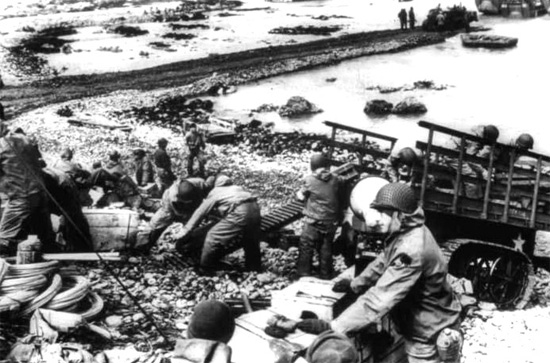
Partial view of landing operations on Kiska Island, Aleutians, 15 August 1943.
Medical Support for the Aleutians Campaign
179th Station Hospital – Adak Island
Fort Glenn Station Hospital – Umnak Island
Fort Mears Station Hospital – Unalaska Island
Fort Randall Station Hospital – Cold Bay, Alaskan Peninsula
Naknek Post Station Hospital, Alaskan Peninsula
Fort Greeley Station Hospital – Kodiak Island
Medical planning for the Kiska invasion relied heavily upon field reports from the Attu operation. The danger of cold injury was treated with utmost seriousness and troops were issued shoepacs, parkas, rain suits, kersey-lined clothing, and wool toques. Special instructions were prepared for care of the men’s feet. After the dramatic circumstances that took place on Attu (medics and litter bearers often being targeted and killed by the enemy –ed), medical personnel were issued individual arms, with Officers receiving .45 automatic pistols or .30 caliber carbines and Enlisted Men M-1 rifles and Thompson submachine guns. Medics now had a fighting chance.
Nearly 3,000 medical personnel accompanied the assault force. Amphibian Task Force # 9 Surgeon was Lt. Colonel H. E. Bill, MC (with a staff of 4 Off & 6 EM –ed), who operated out of Major General Charles H. Corlett Headquarters (CG > Invasion Force). Four landings were planned in 2 major sectors, hence 2 Medical Officers pertaining to the 59th Medical Battalion would act as sector surgeons. In order to ensure self-sufficiency, the 59th Med Bn was first expanded with additional Collecting and Clearing Companies drawn from non-divisional sources. Field Hospital Platoons operating on shore were to carry enough supplies to last thirty-six hours, with following medical units instructed to take along supplies for three days. Additional support in the form of Medical Hospital Ship Platoons and medical maintenance units were loaded on troop transports and cargo vessels for off-shore service and early debarkation. Medical Supply Depots would be set up on every beach for quick distribution. Even 58 parapacks containing emergency medical supplies were foreseen in case units would become isolated.
1943-1944 Operations on Kiska:
The 28th Field Hospital became one of the four Field Hospitals (no female Nurses participated in the operation –ed) on Kiska (6th Field Hospital – 29th Field Hospital – 30th Field Hospital –ed) and served as a station hospital on the island during its stay there. The 3 Hospitalization Platoons and the Headquarters Section had been broken down into four independent units to better fit the Battalion Landing Groups (BLG) causing quite some confusion, as frequent changes occurred prior to the landing. Part of this confusion resulted from the lack of knowledge by higher echelons of the functions, capabilities, and limitations of an organization such as a Field Hospital. Meanwhile the organic equipment which had arrived shortly before the unit’s movement orders had not been fully inspected and effectively demonstrated. There had been no time to include it in the last training phase, yet it had been quickly uncrated, identified, and crudely split among the three Hospital units. Another exchange of units attached to the BLGs resulted in more confusion, as Hospitalization Platoons were once more substituted for others, and it became almost impossible to know and keep trace of who was involved with whom. The changes and last commitments were such that it became impossible for the First Platoons to rejoin their own Headquarters until the end of the active phases of the Kiska operation. To make matters worse, some of the Platoons were further split into two sections, embarking on different LSTs.
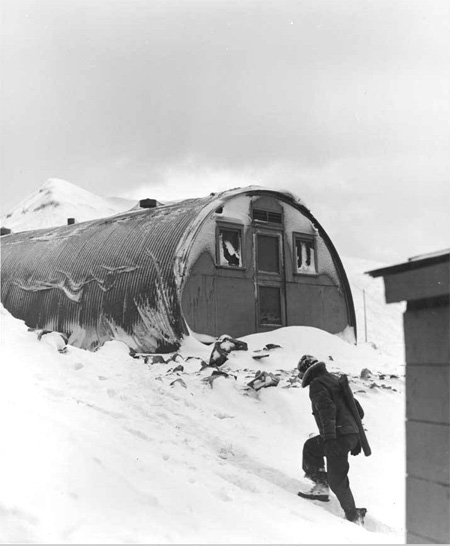
Quonset hut in the Aleutians. Extreme weather and climatic conditions made life miserable in the area.
One of the major medical organizations to operate on Kiska was the Composite 28th Field Hospital which grouped:
Second Hospitalization Platoon – 28th Field Hospital
Third Hospitalization Platoon – 28th Field Hospital
First Hospitalization Platoon – 29th Field Hospital
The other unit was the Composite 29th Field Hospital comprising:
Headquarters Section – 29th Field Hospital
Second Hospitalization Platoon – 29th Field Hospital
Third Hospitalization Platoon – 29th Field Hospital
First Hospitalization Platoon – 28th Field Hospital
The Composite 28th Field Hospital did only disembark on 22 August 1943. As soon as the proper site was selected for the establishment of a hospital, pyramidal tents were erected, equipment unpacked, with the facility opening in the northern sector at 2000 hours the same day (admission of the first 16 patients –ed).
Operations were conducted under extreme difficulty. The area was exposed, rugged, wet, and supplies had to be back-packed from the landing beach through a sea of mud. There was complete disruption of the supply system, and no attempt to control storage and looting. Officers accompanied by some men were forced to search along the beach for medical equipment and supplies, and carry them over rugged terrain to the hospital area. This situation inevitably seriously affected the efficiency of the Hospital, which would have meant disaster if any large number of battle casualties had been received for admission (luckily there were none –ed). While on the island, storage of supplies became problematic. Linen mildewed, plaster deteriorated, the intense cold affected everything, and clutters of different shelters were built, such as Quonset huts, dugouts, basements, wooden huts, pyramidal tents.
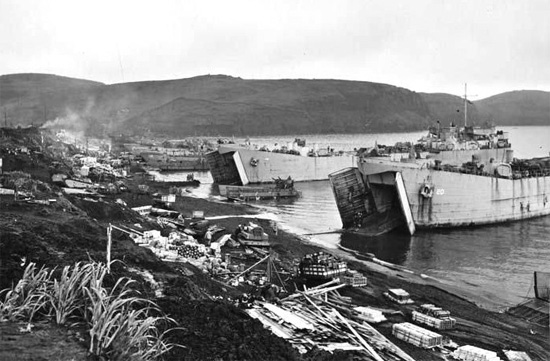
Following the assault LSTs unload their supplies at Kiska harbor.
The First Hospitalization Platoon of the 28th Field Hospital, and the First Platoon of the 29th Field Hospital, were exchanged on 8 September 1943, with each unit finally returning to its original composition (individual strength of Platoon: 18 Officers and 235 Enlisted Men – basic T/O 8-510 dated 28 February 1942, aggregate number: 17 Officers, 18 Nurses, 211 EM –ed). The CG ATF # 9 ordered to prepare the hospital site for building of a permanent Station Hospital. Before starting the necessary excavations, supplies and equipment were transported over the long hills from the beach at Kiska Harbor. Lack of decision, uncertain assignment to a proper area, transportation problems, loss of some vital equipment, delayed efforts at excavating, revetting, and winterizing, certainly increased labor and efforts at a time when inclement weather increased. Local conditions further affected such basic living conditions as related to sanitation, building of latrines, evacuation of waste. Improvisations were necessary to ameliorate overall living; recreation was limited to movies and radios; religious services; occasional shows and song contests, etc.
Return to ZI:
An advance party of 1 Officer left Kiska by boat on 31 January 1944 for Amchitka and then continued by aircraft to Seattle, ZI, in order to make the necessary arrangements for return of the 6th, 28th, 29th, and 30th Field Hospitals, and the 679th Medical Collecting Company. The CO of the 29th Field was appointed overall Troop Commander and had everyone embark on 12 February for Kulak Bay, Adak. After another stop at Dutch Harbor on 15 February 1944, there followed no more delays.
The unit was transferred to the Zone of Interior, arriving at Seattle Port of Embarkation, on 20 February 1944, debarking at 1600 hours. After all personnel, Officers and Enlisted Men, had completed rehabilitation, leaves and furloughs, the organization was again prepared for another overseas movement. Movement orders indicated that the unit should first reorganize under the new T/O 8-510 dated 15 September 1943, transfer personnel deemed unfit for field duty, and initiate a refresher training course for all Medical and Surgical Technicians who had not been properly used for the work they were originally trained for while serving on Kiska.
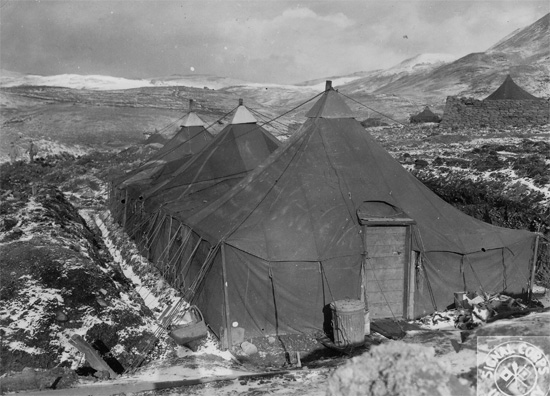
Exterior view of one of the convalescent wards of the 28th Field Hospital at Gertrude Cove, Kiska Island, 26 November 1943.
Preparation for Second Overseas Movement:
The organization departed the Zone of Interior for the European Theater of Operations in May 1944. After arriving in the United Kingdom, and preparing for possible field operations related to D-Day, the 28th Field Hospital operated 3 separate Hospital sites in England. The unit functioned as part of the casualty reception group in southern England, being based at Southampton together with the 46th Field Hospital. Under Southern Base Section command, both units placed detachments near the wharves and hards to receive the most urgent medical cases from the arriving LSTs. A Platoon of the 28th Field occupied a bombed-out brewery on the waterfront using some of the intact premises for wards, operating rooms, and x-ray department, and set up supply, headquarters, and other facilities in tents in the rubble above ground. Such units were often reinforced with auxiliary surgical and shock teams and with medical gas treatment elements. Sanitary company personnel on board ships transferred the patients to the shore, where the non-transportable were tagged, and went directly to the Holding Units such as the 28th or 46th Field Hospitals for immediate treatment. Sanitary and Ambulance Companies carried the other patients to waiting ambulances for further inland evacuation. Expansion of air evacuation combined with a lesser number of casualties from the D-Day invasion combined with the opening of FUSA hospitals on the continent, rendered much of the elaborate network of holding units in the United Kingdom superfluous. Accordingly, Communications Zone Headquarters redeployed the 28th Field from Southampton and returned it to regular duty.
Crossing to the Continent was successfully carried out mid-August 1944 with the organization immediately assigned upon arrival. The majority of the unit’s mission during the latter half of 1944 consisted in Air Holding and Rail Holding work. The Hospital had been assigned to ADSEC, ComZ, and generally operated in or near Third United States Army boundaries. ADSEC operated a number of holding units which constituted an indispensable link between mobile (or semi-mobile) Army Evacuation Hospitals and the usually distant railheads and airfields. They were occupied with receiving sick and wounded by ambulance from the many medical units, permitting the latter to clear out patients promptly and move forward with the troops. Such holding units generally provided shelter, food, and basic supportive and emergency care for a large and rapid turnover of casualties, whom they retained only long enough to accumulate efficient patient loads for subsequent rail or air transportation (as a matter of fact no T/O unit existed for such purpose –ed). In practice, when lines of evacuation were longest, the Armies and ADSEC both had holding units in operation, relaying casualties toward the rear. Holding units behind the Armies as used by ADSEC comprised the 7th – 9th – 12th and 28th Field Hospitals, the 77th Evacuation Hospital, and the 93d Medical Gas Treatment Battalion. Additional detachments were supplemented for service at the various airfields, including smaller units such as the 425th and 428th Medical Battalions. One of the problems was the lack of sufficient transportation, which therefore had to be borrowed from other units. Supplies in the form of mess equipment, folding cots, tentage, and bedding had to be begged from other medical units, and sometimes the units had to revert to captured German supplies. The holding units respectively set up on or near the landing beaches, then went into operation inland as from mid August of 1944, organizing reception and triage of FUSA casualties. TUSA later operated in the same way, opening air evacuation facilities for Third United States Army casualties, usually trying to remain within a practicable ambulance haul of the rearmost Army Hospitals. Similar operations were conducted in the rest of France and in Belgium, following the Armies advance.
1945 Operations in the ETO:
The beginning of 1945 found the 28th Field Hospital functioning with all units together with Headquarters, operating a 600-bed Rail Holding and Evacuation Unit combined with a Station Hospital for the Nancy area, France, since 15 November 1944 (near airstrips A-95 and A-98 –ed). Adequate buildings (the Ecole Professionelle) were provided and adapted to the unit’s needs. The unit’s dispensary served numerous TUSA units.
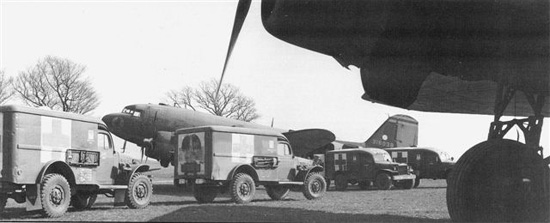
England 27 March 1945. WC-54 3/4-ton ambulances are waiting to receive patients (RAMPs) recently evacuated from France. Some of them will be taken to the 802d Hospital Center, Blandford, England.
A change in function was soon forthcoming and on 10 January 1945 the First Hospitalization Platoon (also designated Detachment “A” –ed) moved to Toul, France (leaving Nancy), relieving a unit pertaining to the 7th Field Hospital to supervise and operate a 1000-bed Rail Holding Hospital for liberated Allied Nationals (RAMPs –ed), utilizing the buildings comprising a French caserne in Toul (air evac took place from airstrip A-96 initially used by fighters and bombers –ed). A large number of Russian, Yugoslav, and Italian acutely ill and undernourished PWs had been grouped in the old caserne by the Germans. Medical and administrative problems were numerous as no preparation had initially been made to take over the installations and receiving activities until after V-E Day. Special diets and feeding, typhus studies, delousing of patients, supply of new clothing, preparation and adaptation of existing buildings and equipments, disciplinary control, re-education in personal hygiene and basic sanitation, were some of the many problems met and solved in this ‘special’ phase of the Hospital’s continental operations.
Rules of conduct and behavior had to be formulated and conspicuously posted in different languages to be understood. The RAMPs, DPs and ex-slave laborers were organized into groups with carefully selected and responsible leaders under the control of Hospital personnel at all times. The method soon began to pay dividends through recognition of organization and authority. The largest nationality represented was from the Soviet Union and the administrative leaders previously selected were a group of maladjusted and disgruntled misfits who were promptly relieved. The Hospital Platoon Commander had to repeatedly demonstrate finesse and tact when dealing with the Russians. It must be stated that liaison groups from the represented Allied Nations presented command problems at all times. The initial Displaced Persons problem of hospitalization was solved by utilizing the Nancy Hospital for reception, screening, study, hospitalization and treatment of all seriously ill cases while the Toul Hospital was used for hospitalization of the less seriously ill and ambulatory patients. Thanks to the efforts of the medical staff, sanitation and personal hygiene rapidly improved and recoveries among the cases with malnutrition became almost commonplace. This was one of the early and difficult joint Soviet-American operations. Assistance was afforded by Russian Medical Technicians and Medical Officers who worked in this area. Many patients were suffering from tuberculosis and pneumonia requiring measures of rigid isolation and preventive medicine (many had been working for more than 3 months in coal or iron mines –ed). From 1 January 1945 to 8 February 1945, a total of 823 patients were treated in Nancy, and 502 at Toul, France.
On 14 February 1945, Third Platoon (Detachment “C”) departed Nancy, for Plombières, France. On 17 February, Headquarters and Second Platoon (Detachment “B”) departed Nancy moving to Toul, France.
On 1 March 1945, Headquarters and Second Platoon (Detachment “B”) left Toul and moved on to Metz, France. On 10 March 1945, the above organizations took over operations relieving the 61st Field Hospital at Metz. The same day, Headquarters, First Platoon, and Second Platoon arrived in St. Florentin, France. They moved once more on 14 March 1945, traveling by motor convoy to Thionville. Between 10 and 11 March 1945, 63 patients were cared for at the Thionville Hospital; and from 14 to 25 March 1945, a total of 1,248 wounded were evacuated.
As the need for more medical field units became apparent (German forces moving steadily eastward –ed), and on 14 March 1945, the entire 28th Field Hospital, less Detachment “C”, relieved the 94th Medical Gas Treatment Battalion, at Thionville, France, to operate another 600-bed Air Holding and Evacuation Hospital at the local airstrip Y-33 (used for transportation –ed).
As US forces continued to move further to the east, the Field Hospital followed, reaching St. Wendel, Germany on 24 March 1945, setting up its Second Platoon (Detachment “B”), while Headquarters together with First Platoon (Detachment “A”) and supplemented by Company “ C”, 93d Medical Gas Treatment Battalion, went on to Mainz, Germany, arriving there on 26 March 1945. While stationed at St. Wendel, Second Platoon was instructed to take care of 150 Soviet Russian RAMPs, cleaning, washing, delousing, and treating the patients, after which they were turned over to another medical unit.
A 500-bed Air Holding and Evacuation Hospital was opened at airstrip Y-64 (at Ober-Holm, used by fighters and bombers –ed), expanded to 700-beds on 29 March, when they were joined by Second Platoon returning from St. Wendel. Extra litter bearers were supplied by another Field Hospital bivouacking nearby. A Company of co-belligerent Italians under the direction of the 1199th Labor Supervision Company was subsequently attached and with some training and supervision worked very well. Evacuation consisted of large groups of recently liberated American and British PWs. At Ober-Holm, a total of 4,487 RAMPs were treated from 26 March 1945 to 21 April 1945. The number of contagious diseases such as mumps, diphtheria, measles, and scarlet fever, was fairly high in these recently liberated groups.
Detachment “C” operated a Station Hospital at St. Florentin, France, on behalf of the 13th Airborne Division, and was released from assignment to ADSEC, ComZ, and re-assigned to the Oise Intermediate Base Section.
On 20 April 1945, Second Platoon (Detachment “B”) departed Ober-Olm for Herzogenaurach, Germany (near Erlangen), where it was joined by Headquarters on 23 April, and by First Platoon on 30 April 1945. The mission consisted in operating another Air Holding and Evacuation Hospital at airstrip R-29 (used for supply and evacuation –ed) supplying x-ray and lab services for units stationed in the vicinity. From 21 April 1945 to 26 May 1945, a total of 3,803 RAMPS were treated at this area.
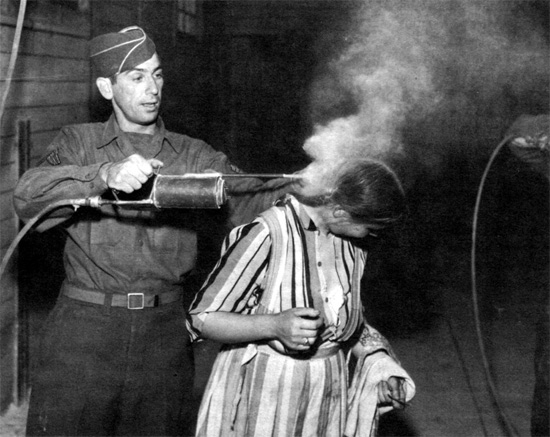
Germany 1945. Recently liberated and recovered Displaced Persons are being dusted with DDT against body insects.
As the war further progressed, the volume of battle casualties to be processed for air evacuation rapidly decreased and began to be replaced by cases of battle fatigue to be evacuated to Army Rest Centers on the Continent and in the United Kingdom. This function then continued until 26 May 1945 when the 28th (except Third Platoon (Detachment “C”) moved to Hörsching, Austria. The organization was henceforth located on one of the largest airfields on the continent, i.e. R-87 (Hörshing Air Base operated by the 79th Fighter Group, Ninth US Army Air Force, flying P-47 fighter-bombers, and also used for general supply and medical evacuation -ed) near Linz, Austria, to supervise the functioning of 2 hospital units staffed by captured German medical personnel, treating Hungarian Jews released from Concentration Camps, and numerous Displaced Persons, including mothers with babies. A total of 2,730 patients were being cared for at these two institutions.
Following the cessation of hostilities in Europe, the 28th Field Hospital was principally concerned with the recovery of Allied Military personnel (RAMPs) and the treatment of the many Displaced Persons (DPs) in Hörsching, Austria.
One Platoon (Detachment “B”) was utilized to supervise hospitalization of a 3,500-bed DP Hospital staffed and operated by German medical units. First Platoon (Detachment ”A”) was used to establish a 400-bed Air Holding and Evacuation Hospital for Displaced Persons originating from Western Europe. 28th Field Hospital Headquarters functioned in their capacity of command, administration, supply, training, and supervision of it all. Labor for this tremendous job was drawn from a nearby German Prisoner of War Enclosure, for which the supervision and guard were supplied by the attached 1199th Labor Supervision Company, an indispensable function with Hospital personnel spread so sparingly through this large Post. Serbian guards were employed and controlled by a TUSA Cavalry Reconnaissance Group, which was charged with overall security of the Post. Initially there were a total of 3,008 DPs in the Hospital operated by the 121st Evacuation Hospital, 30th Field Hospital and the 647th Medical Clearing Company, all now relieved by the 28th. The occurrence of 329 cases of typhus fever offered new challenges to medical personnel acquainted to surgical management. Having worked on German PWs on most of its continental operations prior to entry into Germany, the unit possessed an understanding of the enemy psychology which enabled them to better cope and supervise their work. Sanitation at Hörsching was in a deplorable state despite the excellent building facilities and utilities. After some reorganization and education of all personnel involved, the situation rapidly improved to the satisfaction of everyone concerned. All major surgery was done by 28th Field Hospital personnel, with the German medical units utilized for minor surgery, ward details, and dispensary duty. These people were well-trained, disciplined, and experienced units so that command and management caused no serious problems. Security guard consisted largely of protecting German personnel from DPs who frequently claimed to have recognized former SS guards and attempted to take retaliatory measures against them. Screening by CIC personnel was wholly inadequate, for the necessary staff to cope with the great number of Prisoners of War was unavailable. Language difficulties encountered were no small problem with some 35 different languages spoken by the patients. Most had been in captivity sufficiently long to have learned simple words and commands in German so that ward rules and camp regulations posted in that commonly language (German) obviated the necessity of frequent and continuous repetition.
On 17 June 1945, the 28th Field Hospital, less Third Platoon (Detachment “C”) no longer under its control, was fully assigned to Third United States Army. Prior to this assignment, the unit had been placed in Category II for redeployment.
By 23 June 1945, all transportable Western European Displaced Persons had been evacuated, and personnel were again able to receive American battle casualties from the nearby Evacuation Hospitals for holding and evacuation to General Hospitals in the rear.

United States Army Air Forces Depot located near one of the ADSEC (Advance Section, Communications Zone) Holding Units site. For setting up Holding Units behind the Armies (FUSA and TUSA), the Advance Section usually combined the services of Field Hospitals, Evacuation Hospitals, and Medical Gas Treatment Battalions. Picture taken in France or in Germany.
During July and August 1945, the DP population treated by the 28th declined greatly from a total of over 4,500 patients to a few 100. In spite of difficulties in obtaining adequate rations and medical supplies for treatment of DPs in such large numbers, a high standard of medical assistance was provided. Past experience gathered at Toul, France, was valuable. Professional treatment provided for DPs was extended by German Army medical personnel under professional guidance of MC Officers of the 28th Field Hospital. By the end of August a majority of PW personnel were lost through general release or were detained in PW camps. The last of these men, belonging to the German 126th Feldlazarett were turned in to the Wegscheidt Lager at Linz, Austria, following evacuation of the last Displaced Persons. The Hörsching medical facility housing the 28th Station Hospital and dispensary (operated by First Platoon) for treating US military personnel were closed on 1 September 1945. A total of 14,213 patients were treated by the 28th, which at times was functioning with only 2 Platoons.
Starting 2 September 1945, Second Platoon was placed on TD with the 104th Evacuation Hospital at Bad Weissee, Germany, to provide personnel for maintenance of the Station Hospital in Bad Weissee during redeployment of high-point EM, and pending departure of the 104th Evac Hosp for the Assembly Area Command and ultimate redeployment.
Headquarters and First Platoon arrived in Ingolstadt, Germany, on 6 September 1945 and continued operating a Station Hospital for units of the 9th Infantry Division (originally established by the 34th Evacuation Hospital). Second Platoon arrived on 20 September, while Third Platoon rejoined the organization only on 3 November 1945. Hospital installations at Ingolstadt closed at 2400 hours, 17 November 1945. Prior to this, Lt. Colonel James Ensey, MC, Commanding Officer, was relieved of his assignment and returned to the Zone of Interior for separation, as were some other high-point Officers in the unit.
Frequent changes in personnel, study of Readjustment and Redeployment directives, Information & Education programs, together with intensive reconditioning of all personnel, were in effect at the close of July 1945, with the future status of the Hospital in doubt.
Transfer & Changes in Personnel:
The Hospital continued to operate in Germany. Beginning August 1945, unit strength was as follows: 17 Officers – 12 Nurses – 126 Enlisted Men, with additional personnel from the 130th Station Hospital and from the 29th Field Hospital assigned to work with the organization.
Officers:
1st Lieutenant Preston R. Woodham, MAC, was assigned and joined the 28th Fld Hosp, from the 7th Medical Depot Company on 1 August 1945. 1st Lieutenant George R. Stevens, MAC, was released from assignment and transferred to the 7th Medical Depot Company on 1 August 1945.
1st Lieutenant Frank B. Hamilton, MAC, was released from TD with the Hospital and returned to his parent organization, the 97th Evacuation Hospital, on 2 August 1945. 1st Lieutenant Leon R. Richman, MAC, was released from assignment and transferred to the 11th Evacuation Hospital on 2 August 1945.
Captain Onver E. Mahadeen, MC, was released from assignment and transferred to the 514th Medical Collecting Company on 6 August 1945.
1st Lieutenant Naomi S. Reed, ANC, was released from TD and returned to her parent organization, the 130th Station Hospital on 7 August 1945. 1st Lieutenant Susan E. T. Eton, ANC, returned to duty from leave at the Riviera Recreational Area, Nice, France on 7 August 1945. 1st Lieutenant Margery O. Susag, ANC, and 1st Lieutenant Doris N. Golden, ANC were attached for TD from the 130th Station Hospital on 7 August 1945.
Captain Ervin B. Wallace, MC, was released from assignment and returned to his parent organization, the 130th Station Hospital on 8 August 1945.
Captain Jerry A. Lambiente, DC, was assigned and joined from the 2d Convalescent Hospital on 11 August 1945.
Captain Doris Maness, ANC, was released from assignment and transferred to the 135th Evacuation Hospital on 13 August 1945. 1st Lieutenant Preston R. Woodham, MAC, was placed on TD with the Surgeon’s Office, Seventh United States Army Headquarters on 13 August 1945. 1st Lieutenant Amy G. Erickson, ANC; 1st Lieutenant Victoria Hansen, ANC; 1st Lieutenant Vera J. Lee, ANC; 1st Lieutenant Alice S. Marks, ANC; 1st Lieutenant Fern H. Wingerd, ANC; 1st Lieutenant Anna M. Ziegler, ANC; were all attached for TD from the 95th Evacuation Hospital on 13 August 1945. 1st Lieutenants Gertrude M. Hickey, ANC, and Mary C. Tkacik, ANC, were attached for TD from the 93d Evacuation Hospital on 13 August 1945.
1st Lieutenant Dorothy L. Brown, ANC, returned to duty from sickness and treatment at the 26th Field Hospital on 14 August 1945. 1st Lieutenants Ester R. Ranck, ANC; Carolyn C. Henna, ANC; and Caroline Davis, ANC; were all attached for TD from the 93d Evacuation Hospital on 14 August 1945.
1st Lieutenant Dorothy L. Brown, ANC, returned from treatment at the 26th Field Hospital and went over to sick leave at the 21st General Hospital, Mirecourt, France, on 15 August 1945. Majors Joseph H. Humpert, MC, and Joseph C. Kent, MC; were assigned and joined the unit from the 67th Field Hospital on 15 August 1945.
Major Joseph C. Kent, MC, was released from assignment and transferred to the 15th General Hospital on 16 August 1945.
1st Lieutenant Minnette Smulyan, ANC, returned to duty from 7 days leave at the Riviera Recreational Area, Nice, France on 18 August 1945. Captain John R. Torney, MAC, returned to duty from leave at the Riviera Recreational Area, Nice, France on 18 August 1945.
1st Lieutenant Vera L. Sheaffer, ANC, was attached for TD from the 93d Evacuation Hospital on 20 August 1945.
Captains Alois M. Bachhuber, MC; Donald L. Buchanan, MC; Jacob Lichstein, MC; Thomas P. Waring, MC; 1st Lieutenants Opal L. Forrester, ANC; Betty G. Roos, ANC; Josephine Martinez, ANC; Margery O. Susag, ANC; and Doris N. Golden, ANC; all attached for TD from the 26th Field Hospital went to duty with the 130th Station Hospital on 22 August 1945.
1st Lieutenants Gertrude M. Hickey, ANC; Mary C. Tkacik, ANC; Ester R. Ranck, ANC; Carolyn C. Henna, ANC; Caroline Davis, ANC; Vera L. Sheaffer, ANC; returned from TD to their parent organization, the 93d Evacuation Hospital on 24 August 1945. 1st Lieutenants Amy G. Erickson, ANC; Victoria M. Hansen, ANC; Vera J. Lee, ANC; Alice S. Marks, ANC; Fern H. Wingerd, ANC; and Anna M. Ziegler, ANC; all returned from TD to the 93d Evacuation Hospital on 24 August 1945. Captain Pasquale Milazzo, MC, was assigned and joined from the 11th Evacuation Hospital on 24 August 1945.
Captain James F. Weisert, DC, and 1st Lieutenant William O. Goffingen, MAC; were released from assignment and re-assigned to the 11th Evacuation Hospital on 25 August 1945. Captain Pasquale Milazzo, MC, was placed on TD with the 11th Evacuation Hospital on 25 August 1945. 1st Lieutenant Dorothy L. Brown, ANC, was released from assignment and re-assigned to the Detachment of Patients 4401, US Army Hospital Plant, APO 513, 21st General Hospital, on 25 August 1945. 1st Lieutenant Hazel Belsit, ANC, was assigned and joined from the 29th Field Hospital on 25 August 1945. Captain William A. Reed, MC, was released from assignment and transferred to the 2d Convalescent Hospital on 25 August 1945. Captain Roscoe Constantine, MC, was released from DS and returned to his parent organization, the 29th Field Hospital on 25 August 1945. Captain Kurt Abraham, MC, was released from DS and returned to his parent organization, the 57th Field Hospital on 25 August 1945.
Captain Vincent D. Castrigano, DC, was assigned and joined from the 317th Station Hospital on 28 August 1945.
Captain Vincent D. Castrigano, DC, returned to TD to the 317th Station Hospital on 29 August 1945.
1st Lieutenant Preston R. Woodham, MAC, returned from TD to the Surgeon’s Office, Seventh United States Army Headquarters on 30 August 1945.
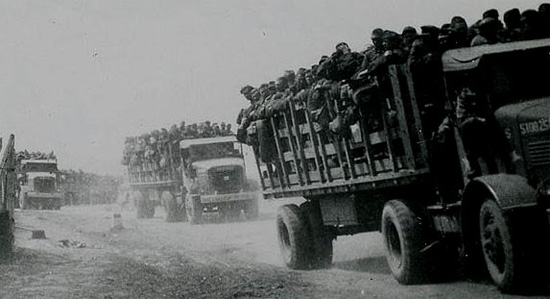
Germany 1945, enemy Prisoners of War are transported to PWTEs by Army trucks.
Noncommissioned Officers & Enlisted Men:
Sergeant James A. Langly, Private First Class Alton G. Meredith, Private First Class Merle W. Spaulding, and Private First Class Lester W. Tuthill; all returned to duty from 7 days furlough in England on 3 August 1945.
Private First Class William E. Haslan, was released from assignment and attached as Unassigned Enlisted Personnel to the 19th Reinforcement Depot for return to the Zone of Interior on 5 August 1945.
Sergeant Loris D. Jacobs, was placed on DS with the Army University Center No. 2, Biarritz, France on 13 August 1945. Technician 3d Grade Albert R. Utecht, was taken up with sickness at the 26th Field Hospital on 13 August 1945. Private First Class William C. Seegeldt, was reduced to the grade of Private on 13 August 1945.
Private First Class James D. Scott, was placed on DS with the 327th Station Hospital, Etampes, France, on 16 August 1945.
Technician 3d Grade Albert R. Utecht, was released from assignment and transferred to Detachment of Patients 4377, US Army Hospital Plant, 97th General Hospital on 18 August 1945. Technician 4th Grade Fred M. Bradberry, Technician 5th Grade Charles C. Frederico, Technician 5th Grade Casimir F. Oldynski, Technician 5th Grade Kenneth C. Schenk, Private Fist Class James J. Burnes, Private First Class Joseph J. Dzierawiec, Private First Class Robert J. Sherman, and Private Frederick W. Will; all returned to duty from 7 days furlough at the Riviera Recreational Area, Cannes, France on 18 August 1945. Private First Class Henry H. Corton, returned to duty from 7 days furlough visiting southwestern France on 18 August 1945.
Private First Class Claude M. Fowler, was released from assignment and attached as Unassigned Enlisted Personnel to the 19th Reinforcement Depot for returning to the Zone of Interior on 22 August 1945. Technician 3d Grade Den L. Wassmer, Technician 5th Grade William W. Faller, Technician 5th Grade Kenneth C. Seaman, Private First Class William K. Wiens; all on TD at the 26th Field Hospital, returned to duty with the 130th Station Hospital on 22 August 1945.
Private First Class Joseph F. Felice, was released from assignment and transferred to the 388th Medical Collecting Company on 24 August 1945.
Technician 3d Grade Sam A. Oddo, Private First Class Herman D. Asbury, and Private First Class Christopher Puleo, on DS with Headquarters Detachment, Central Laboratory, CONAD Headquarters and on TD with the 28th Field Hospital were placed on further TD with the 11th Evacuation Hospital on 25 August 1945.
Private First Class Tom J. Hewatt, was released from assignment and transferred to the 57th Field Hospital on 27 August 1945. Private First Class James D. Scott, on DS at the 327th Station Hospital was released from assignment and transferred to the 57th Field Hospital on 27 August 1945.
Staff Sergeant Odis F. Crockett, Staff Sergeant Angelo DeVive, Staff Sergeant Thomas J. Zauchs, Technician 4th Grade Clyde Glover, Technician 4th Grade Hilliard K. Wimberley, Corporal Bradley T. Trim, Technician 5th Grade John W. Kasprzyk, Technician 5th Grade Charles A. Pillot, Technician 5th Grade Louis Boudreaux Jr., Private First Class Howard S. Crawford, Private Dewitt Barefield; were all transferred to the 589th Field Artillery Battalion on 28 August 1945.
Technician 5th Grade Stanley F. Schab, returned to duty from absence for sickness at the 50th General Hospital on 29 August 1945.
The 28th Field Hospital which functioned at Ingolstadt, Germany, subsequent to 20 September 1945, was with the exception of a few Officers and Enlisted Men, an entirely new unit! Under the subsequent command of Lt. Colonel Leon C. Freek, MC, and Lt. Colonel D. W. Clotfelter, MC, the organization continued to function until 17 November 1945, at which time it was alerted for movement to “Camp Philadelphia”, France, for return to the United States. The last official report dated 24 November 1945, was filed and signed by Major W. Trask, MC, Commanding Officer, 28th Field Hospital, APO 403.
From 1 January 1945 to 30 June 1945, a total of 16,066 patients were hospitalized and treated by the 28th Field Hospital for a total of 92,246 patient days.
Military & Civilian Personnel:
Medical Corps Officers:
Generally speaking, the Hospital staff was maintained intact for 1945. One younger Medical Officer was transferred to the 3d Armored Division to replace a Battalion Surgeon and fitted in excellently. In June 1945, R & R took another of the few Surgeons in the unit; Captain Estel B. McCollum who was indeed transferred on an exchange basis to the 83d Field Hospital (a unit that was to be redeployed directly to the Asiatic-Pacific Theater with its entire staff).
Dental Corps Officers:
In January 1945, owing to an acute shortage of Dental Surgeons in TUSA, it became necessary to transfer one of the 28th Field Hospital DC Officers to that command. The deficiency was made up to achieve T/O strength in this department. With 3 Dental Officers assigned to the unit, there was ample free time available for prosthetics, especially when the Hospital operated in a static position.
Administrative Corps Officers:
Changes in this group came about because of the need for Infantry Officers. One MAC Officer went to Infantry Training School shortly before the end of hostilities in the ETO. Another one was transferred as a MAC Officer to an Airborne Division. Only one replacement was received by the organization.
Army Nurse Corps Officers:
The usual high standards of the Corps were maintained within the command. There was little change as it involved the loss of only one Nurse through rotation. No replacement was received.
When 3 Hospital Platoons functioned separately, 6 Nurses per Platoon was an adequate number (not always applied).
Chaplain Corps Officers:
The same Chaplain assigned in 1944 remained with the unit.
Enlisted Men:
In late 1944 and early 1945 when it became necessary for Service Units to furnish Infantry reinforcements, a very difficult period was encountered. 27 trained Enlisted Men were lost in exchange for Limited Assignment personnel at a time when the Hospital was very busy. The men were completely unfamiliar with the work peculiar to a Field Hospital and had to be gradually trained in order to become fully integrated.

A patient is being prepared for an X-ray. Holding units were either set up under tentage, prefab hutments, or in existing buildings, whenever available. ADSEC Air and Rail Holding Units formed a chain of evacuation very close to the frontlines. Those situated at Verviers (Belgium) primarily served the First United States Army; the ones at Liège (Belgium), served the Ninth US Army; and the units serving at Nancy, Etain, and Thionville (France) supported General G. S. Patton’s Third United States Army.
American Red Cross Personnel:
The 2 young ARC ladies assigned to the organization did an excellent job and were still with the 28th at the close of the war. They were much appreciated by EM and Officers alike.
Other Civilian Personnel:
While engaged in operations in France, only a few civilians were hired. Language barriers contributed to no better than a satisfactory performance on the part of these employees. Since its arrival in Austria, the 28th engaged large numbers of Austrian and German technicians and laborers, although the same language difficulties affected supervision, on the whole the caliber of work appeared to be more satisfactory than in France.
Training:
A considerable amount of training was accomplished during the early part of 1945, because of the personnel turnover, especially in the Enlisted department. For the most part the unit relied on on-the-job training, since there was little opportunity afforded for off-the-job and/or classroom work. Continued emphasis was placed on motion pictures as an aid to orientation. Separate practical training in the maintenance of gasoline engines and electrical equipment was given too.
Equipment & Supplies:
Procurement during 1945 was attended with the usual difficulties experienced in a fast moving campaign.
A solution was found to one of the supply problems peculiar to operating an Air Holding Unit. Therefore no property exchange was effected on air evacuation. In March 1945, this procedure was amended so that aircraft earmarked for evacuation of litter cases brought in both litters and blankets for exchange. This prevented the wholesale depletion of wool blankets and litter stocks in the Air Holding Unit.
Between January and June 1945 ample stocks of all medical supplies were available. Medical Supply Depots were strategically well spotted and there were no serious problems in maintaining supply levels with respect to demand by hospitalized military personnel.
Securing medical supplies for Displaced Persons was another problem. German supply dumps, both civilian and military, were exploited for supplies. There were understandably shortages which became more acute every day. The problem was expected to lessen in time by evacuation of the DPs from Germany.
Transportation:
The start of 1945 found the Hospital’s organic transportation with eight hard months of wear and tear on it. Maintenance and repair problems became increasingly difficult to solve. Repair echelons however continued to remain adequate.
During the first few months of 1945, there was almost a one hundred percent turnover in transportation personnel. This was due to the policy of replacing General Assignment men in Service Units, with Limited Assignment Personnel, requiring considerable training and reshuffling to correct deficiencies.
Housing, Water Supply, Bathing Facilities and Laundry:
Housing created no problems. The unit generally operated and lived under canvas and adequate fuel for heating and cooking was available during the cold winter months. During January and February 1945, the Hospital was fortunate in being housed in a modern centrally-heated School building for operations and billets (with civilian technicians employed for utilities maintenance). Bathing facilities were adequate and the organic shower unit was excellent.
Laundry was either handled on an exchange basis with a Medical Depot or done by Quartermaster Laundry Units nearby or in the neighborhood. The portable washing machines (part of the organization’s T/E) were totally inadequate.
By end June 1945, the 28th was set up in a large undamaged hangar used as a Hospital, with wooden partitions constructed for the different departments.
Food & Messing, Sewage & Waste Disposal, Insect Control:
Food was for the most part good, and there were no clear cut cases of avitaminosis in the command. Likewise, there were very few cases of gastro-enteritis. Sanitary Technicians were very conscientious and did excellent work.
Sewage and waste disposal was accomplished through city facilities when staying in Nancy, France. In the field, civilians were contracted for disposal of garbage. Deep soakage pits and Quartermaster Box Latrines were exclusively used in the field. Insect control was never a problem. Pouring oil around the latrines, using fly paper in kitchen and mess halls, and individual use of DDT always proved effective.
Venereal Disease Control:
There were no cases of VD in this command. Continual publicizing of the effect of Venereal Disease, issue of prophylactic kits, and the non-fraternization policy all contributed to this remarkable record.
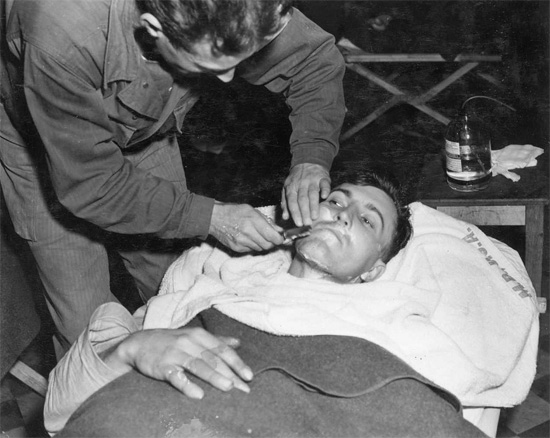
Patient gets a shave, while in hospital.
Recommendations & Desired Changes:
A proposed T/O for a 750-bed Air/Rail holding Hospital was prepared, including desired changes in personnel and equipment. The following recommendations were submitted:
Litter Bearers: increase the number of litter bearers from 30 to 45
Utilities Personnel: introduction of utilities personnel, such as Medical Equipment Technician (SSN-MOS 229), Utilities Repairman (SSN-MOS 121), Carpenter (SSN-MOS 050), General Electrician (SSN-MOS 078).
Administrative Personnel: replacement of General Clerk by Technician 4th Grade Stenographer.
Security: provision for Security Guard (not included in T/O), it is suggested to integrate a small MP Detachment consisting of 1 Sergeant, 2 Corporals, and 8 Privates First Class or Privates.
Internal Communications: provision of internal telephone system, it is suggested to incorporate an internal communication system consisting of 1 switchboard (12 drop) and 10 field type telephones, for efficient operation.
Water Supply: increase the number of 250-gallon water trailers (only 2 available), and replace with one 750-gallon Engineer Tank Wagon and one 1500-gallon Portable Canvas Storage Tank.
Bath Unit: provision of 1 Bath Unit and Field Mobile Trailer, which is believed to be vital and essential for a Holding Unit.
Generator: adaptation of 30 KW Generator on Mobile Trailer for ease of transportation and avoidance of frequent loading and unloading.
Tentage: improve inadequate tentage, most practical method is to use ward tents hooked together with pyramidal tents. Squad tents can only accommodate up to 728 patients, whereas ward tents have room for 750 patients. The total number of 56 squad tents as wards is too little. There is no provision for extra T/E tentage for supply, admission and disposition, x-ray, laboratory, pharmacy, dispensary, dental clinic, surgery, isolation, chaplain, nursing, personnel quarters. Latrine screens are adequate in the field but not for hospital units where both male and female personnel are involved (equipped pyramidal are suggested as more practical for this purpose).
Trays: inadequate number of trays. 250 are not enough as both litter and ambulatory patients are involved in an holding operation. There should be 750 trays, and more cups and tableware including knives, forks, and spoons.
Water Heaters: they are invaluable, as only Immersion-type heaters are provided, they should be added as T/E equipment. Immersion Heaters are dangerous for use inside tents because of fire hazard, smoke, and fumes.
Collapsible Litter Carriers: wheeled litters or carriers serve no useful purpose in a Holding Unit as they take up valuable transportation space and involve unnecessary loading, unloading, and storage.
The organization’s T/E does not include nail pullers and banding machine for packing and re-crating operations.
Campaign Awards – 28th Field Hospital
Aleutian Islands
Northern France
Central Europe
We are very thankful for the help provided by Lynn F. McNulty, son of Veteran, Captain Frederick J. McNulty (ASN:O-526873) who supplied the MRC Staff with copies of historical Reports covering the majority of WW2 operations of the 28th Field Hospital. We are still looking for data relating to the 1944 history of subject unit in the European Theater as well as a complete personnel roster. Any help welcome. All inputs welcome. Thank you.
